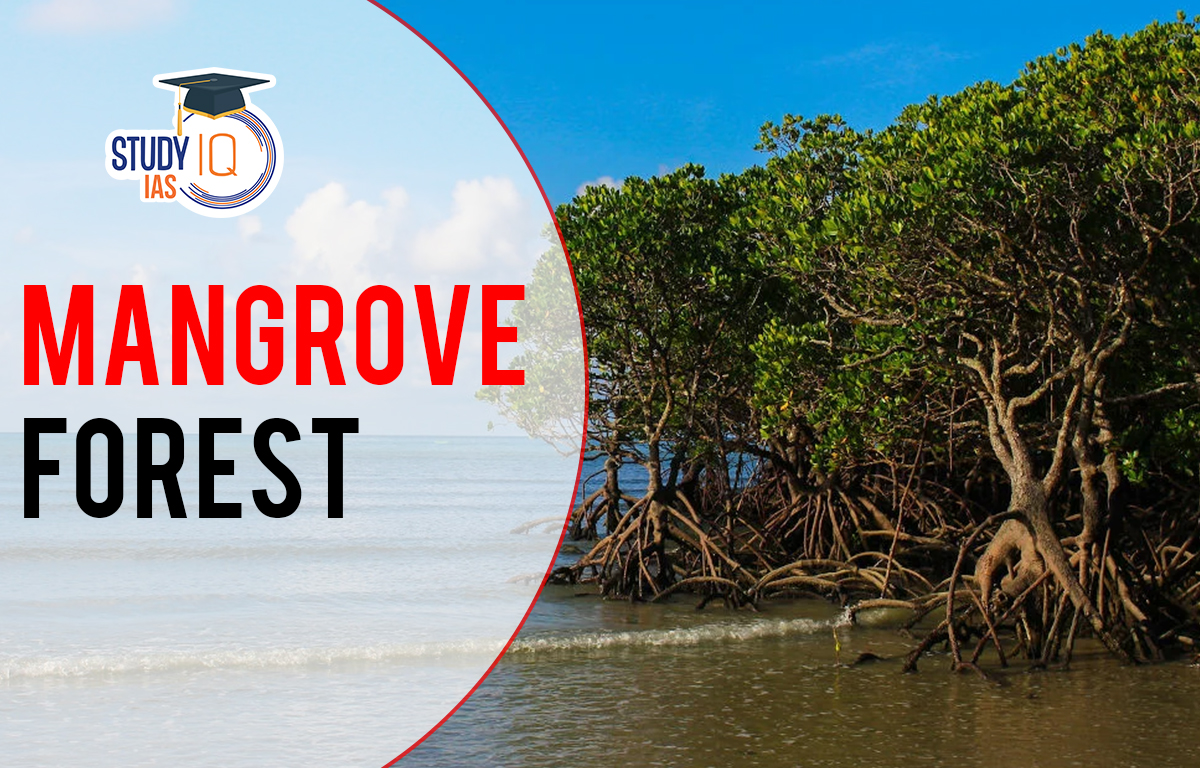Table of Contents
Context: Infrastructure development activities in Mumbai and its surrounding regions are negatively impacting mangroves.
About Mangroves
- Mangroves are an ecotone between a marine and terrestrial ecosystem.
- They act as natural barriers against storm surges, preventing coastal erosion and providing habitats for various species.
Characteristics of Mangroves
- Temperature: Mangroves grow best in tropical and subtropical climates, where temperatures range between 25°C and 35°C.
- Salt Tolerance: Mangroves are highly tolerant of saline (salty) conditions (Halophytes).
- Aerial Roots: Mangrove trees have specialised roots called pneumatophores (blind roots) that rise above the water level to absorb oxygen.
- Vivipary: Mangroves exhibit viviparity mode of reproduction, e. seeds germinate in the tree itself (before falling to the ground).
- Carbon Storage: Mangroves are known for their ability to sequester large amounts of carbon. They play a significant role in mitigating climate change.
Mangrove Cover in India
- According to the latest India State of Forest Report (ISFR) 2021:
- India has 4,992 square kilometres of mangrove cover.
- This represents 15% of the country’s total geographical area.
- States with the largest mangrove cover:
- West Bengal
- Gujarat
- Andaman and Nicobar Islands
- Maharashtra
- Odisha
| Did You Know |
|
Mangrove Forests in India
Mangrove Forests in India: Mangrove forests are unique coastal ecosystems found in tropical and subtropical regions They are made up of trees and shrubs that can live in salty water, growing where land meets the ocean. Mangroves are important homes for many fish, birds, and other animals. India has mangrove forests covering 4992 sq. km, found in nine states and three union territories, according to the 2021 State of Forest Report. This is only 0.15% of India’s total land area and 3.3% of the world’s mangroves.
The mangrove types are:
- Very dense: 1,475 sq. km (29.55%)
- Moderately dense: 1,481 sq. km (29.67%)
- Open mangroves: 2,036 sq. km (40.78%)
From 2017 to 2019, the eastern coast gained 54 sq. km (1.10%) of mangroves. Overall, there was an increase of 946 sq. km (23%) from 1987 to 2021.
Types of Mangrove Forests
Mangroves are coastal plants found along warm, sheltered shorelines. These trees and bushes grow well in areas where the water rises during spring tides and can handle salty water very well. These areas are hot, with temperatures between 26°C and 35°C, and have high rainfall (1,000 to 3,000 mm). Mangrove trees have unique roots to help them survive storms and high salt levels:
- Support roots: Underwater roots for stability.
- Air roots: Roots that grow above the mud.
- Stilt roots: Roots that come out from the main stem.
There are different types of mangroves:
- Red mangroves: Found on coasts.
- Black mangroves: Known for their dark bark.
- White mangroves: Grow at the highest spots.
Mangroves are important habitats for many marine animals like shrimp, crabs, and fish. They help protect coastlines from storms and erosion and provide resources for local communities.
Mangrove Forest Global Distribution
Mangrove forests are found around the world in warm tropical and subtropical areas, mostly between 25° North and 25° South. They can grow a bit further north in places like Japan and Bermuda, and further south in New Zealand, Australia, and the east coast of South Africa.
Mangroves need warm, salty water, so they are located along the coasts of 113 tropical and subtropical countries, covering more than 137,000 square kilometers (about 85,000 square miles). About 75% of the world’s mangrove forests are in just 15 countries.
The largest area of mangroves is in Asia, covering 5.55 million hectares, followed by Africa (3.24 million hectares), North and Central America (2.57 million hectares), and South America (2.13 million hectares). About 40% of the world’s mangroves are in Southeast Asia and South Asia.
According to the 2021 report, over 40% of all mangroves are found in just four countries: Indonesia (19%), Brazil (9%), Nigeria (7%), and Mexico (6%). Malaysia, Papua New Guinea, and Australia also have significant mangrove areas.
Mangroves Forests in India
India has about 3% of the mangrove cover in South Asia, which itself makes up 6.8% of the world’s total mangroves. Southeast Asia holds around 40% of all mangroves globally. Recently, India’s mangrove cover increased by 54 sq km (1.10%), bringing the total to 4,975 sq km (or 1.2 million acres), which is 0.15% of the country’s total land area.
The Sundarbans in West Bengal alone make up over half of India’s mangrove area. India’s mangrove cover includes 42.45% in West Bengal, 23.66% in Gujarat, and 12.39% in the Andaman and Nicobar Islands. Gujarat showed the biggest increase in mangrove forest cover, growing by 37 square miles.
- West Bengal (2114 sq km),
- Gujrat (1140 sq km),
- A&N Islands (617 sq km),
- Andhra Pradesh (404 sq km)
- Maharashtra (304 sq km)
Kerala (9 sq km) and Puducherry (2 sq km) are the states and UTs with the least amount of mangroves, respectively. The Environment Ministry built the National Mangrove Genetic Resource Center in Bhitarkanika (Odisha) for research and development.
Significance of Mangroves Forests in India
1. Ecological Stabilization
Mangroves are very important for the environment. They help clean up waste and store water, which helps keep the soil healthy. They also protect against cyclones and strong storms. Mangroves help form new land, stabilize mud banks, reduce wind energy, and manage tidal and wave energy.
2. Mangroves and Tides
The trees can withstand the tides’ daily rise and fall thanks to their complex web of roots. Most mangroves have at least two daily floods.
3. Coastal Stabilization
In order to prevent erosion from storm surges, currents, waves, and tides, mangrove trees stabilise the coastline.
4. Water Purification
By collecting nutrients from runoff that may otherwise result in toxic algal blooms offshore, mangroves enhance the quality of the water. Mangrove trees’ capacity to cleanse the water is essential to the health and clarity of coral reefs and seagrass habitats.
5. Storing Blue Carbon
Mangroves make up less than 2% of ocean ecosystems, but they help store 10-15% of carbon. When leaves and old trees die, they sink to the seafloor, where the carbon is buried in the soil. This buried carbon, found in places like mangrove forests, seagrass beds, and salt marshes, is called “blue carbon” because it’s stored underwater.
6. Supporting Biodiversity
A staggering variety of organisms, including those that are only found in mangrove forests, are supported by the mangrove ecosystem. A variety of animals, including birds, fish, insects, mammals, and plants, can find habitat and safety there.
7. Fishery
The significance of mangroves for coastal fishing communities is highlighted by the necessity of these ecosystems for the reproduction and nesting of fish and shellfish, migratory birds, and sea turtles. Mangrove forests are thought to be directly or indirectly responsible for 80% of the world’s fish catch, according to a 2008 Journal of Sea article.
8. Tsunami Shield
Mangroves are important for protecting coastal communities from tragedies like tsunamis and storm surges because they can absorb wave energy. Mangroves have a 70–90% effective absorption rate for typical wave energy. It is clear that mangroves’ extensive root and branch systems could assist mitigate the destructive impact of tsunamis even in the most extreme situations.
Threats to Mangrove Forests in India
1. Commercialization of Coastal Areas
Salt-tolerant mangrove trees and their ecosystems are being quickly replaced by shrimp farming, coastal development, rice and palm oil farming, and industrial activities. According to UNESCO, mangroves are disappearing three to five times faster than other forests due to urban growth and changes in farmland. In the last 40 years, the area covered by mangroves has been cut in half. Mangroves make up less than 1% of tropical forests.
2. Shrimp Farms
At least 35% of the loss of mangrove forests is due to shrimp farms. Shrimp farming has become more common because of the increasing demand for shrimp in countries like China, Japan, Europe, and the United States.
3. Temperature Related Issues
Some mangrove species can be killed by freezing temperatures for even a few hours, and temperature fluctuations of ten degrees in a short period of time can harm plants.
4. Soil Related Issues
Plants have a hard time getting enough oxygen in the soil where mangroves grow. Most plants can get oxygen from the air in the soil, but mangrove roots often stay underwater, sometimes getting flooded twice a day, which makes it difficult for them to breathe.
5. Excessive Human Intervention
Mangroves can move further inland when sea levels change, but in many places, human activities block their movement. Oil spills also often damage mangrove forests.
Important Mangrove Sites in India
| Mangrove Sites | State/Union Territories |
| Sunderbans | West Bengal |
| Bhaitarkanika Mahanadi Subarnarekha Devi-Kauda Dhamra Mangrove Genetic Resources Centre Chilka |
Orissa |
| Coringa East Godavari Krishna |
Andhra Pradesh |
| North Andaman Nicobar |
Andaman & Nicobar |
| Pichavaram Muthupet Ramnad Pulicat Kaznuveli |
Tamil Nadu |
| Vembanad Kannur (North Kerala) |
Kerala |
| Coondapur Dakshin Kannada/ Hannavar Karwar Mangalore Forest Division |
Karnataka |
| Goa | Goa |
| Achra-Ratnagiri Dev Garh-Vijay Durg Veldur Kundalika-Revdnada Mumbra-Diva Vikroli Shreevardhan Vaitarna Vasai-Manori Malvan |
Maharashtra |
| Gulf of Kutchh Gulf of Khambhat Dumas-Ubhrat |
Gujarat |


 Topological Materials: The Future of Qua...
Topological Materials: The Future of Qua...
 China’s Deep Sea Station in South Chin...
China’s Deep Sea Station in South Chin...
 Project ICE-CRUNCH: India-Switzerland Co...
Project ICE-CRUNCH: India-Switzerland Co...





















